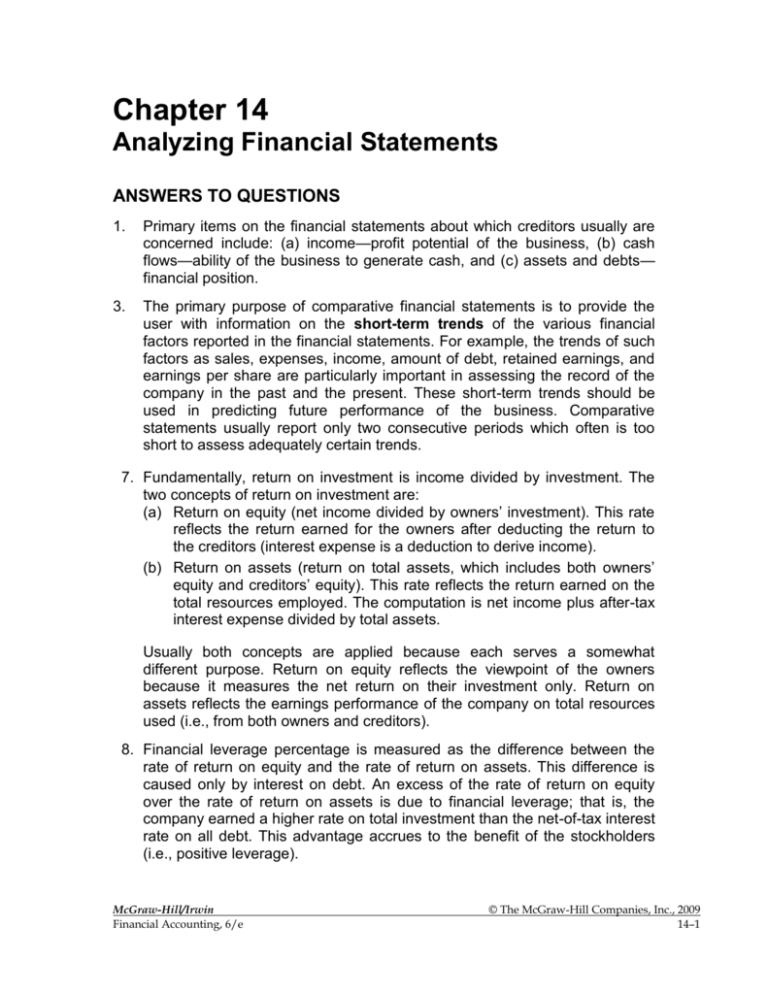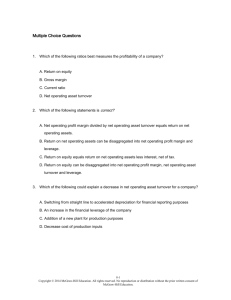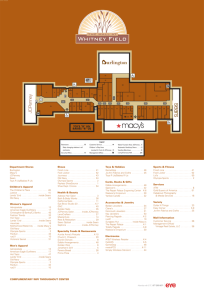Chapter 14
advertisement

Chapter 14 Analyzing Financial Statements ANSWERS TO QUESTIONS 1. Primary items on the financial statements about which creditors usually are concerned include: (a) income—profit potential of the business, (b) cash flows—ability of the business to generate cash, and (c) assets and debts— financial position. 3. The primary purpose of comparative financial statements is to provide the user with information on the short-term trends of the various financial factors reported in the financial statements. For example, the trends of such factors as sales, expenses, income, amount of debt, retained earnings, and earnings per share are particularly important in assessing the record of the company in the past and the present. These short-term trends should be used in predicting future performance of the business. Comparative statements usually report only two consecutive periods which often is too short to assess adequately certain trends. 7. Fundamentally, return on investment is income divided by investment. The two concepts of return on investment are: (a) Return on equity (net income divided by owners’ investment). This rate reflects the return earned for the owners after deducting the return to the creditors (interest expense is a deduction to derive income). (b) Return on assets (return on total assets, which includes both owners’ equity and creditors’ equity). This rate reflects the return earned on the total resources employed. The computation is net income plus after-tax interest expense divided by total assets. Usually both concepts are applied because each serves a somewhat different purpose. Return on equity reflects the viewpoint of the owners because it measures the net return on their investment only. Return on assets reflects the earnings performance of the company on total resources used (i.e., from both owners and creditors). 8. Financial leverage percentage is measured as the difference between the rate of return on equity and the rate of return on assets. This difference is caused only by interest on debt. An excess of the rate of return on equity over the rate of return on assets is due to financial leverage; that is, the company earned a higher rate on total investment than the net-of-tax interest rate on all debt. This advantage accrues to the benefit of the stockholders (i.e., positive leverage). McGraw-Hill/Irwin Financial Accounting, 6/e © The McGraw-Hill Companies, Inc., 2009 14–1 9. Profit margin is the ratio between net income and net sales. It reflects performance in respect to the control of expenses to net sales but is deficient as a measure of profitability because it does not consider the amount of resources (i.e., investment) used to earn the income amount. Profitability is best measured as the ratio of income to investment. EXERCISES E14–10. = 38.2 % Rate of return on equity $4,341 ÷ ($13,930 – $2,570) Rate of return on assets [$4,341 + ($2,570 x .08 x .7)] ÷ $13,930 Financial leverage percentage (positive) = 32.2 % = 6.0 % E14–15. Current Ratio $811,805 $403,038 = 2.01 Inventory Turnover $1,515,815 [($231,741 + $198,000) ÷ 2] = 7.05 Account Receivable Turnover $2,224,140 * [($408,870 + $389,905) ÷ 2] = 5.57 * $3,706,900 x 60% = $2,224,140 McGraw-Hill/Irwin 14–2 © The McGraw-Hill Companies, Inc., 2009 Solutions Manual PROBLEMS P14–4. JCPenney is the stronger company and probably the better investment. JCPenney has a higher gross profit margin, which means that they make more gross profit on each dollar of sales than does Sears. This is very significant since the two companies are in the same business, and operate in the same way. The higher gross profit for JCPenney is also reflected in its higher profit margin and stronger return on assets and return on equity. The JCPenney capital structure includes more debt which gives the company a higher degree of financial leverage. Their investors receive a higher return on equity but there is additional risk. JCPenney is paying dividends while Sears is not. The P/E ratio for Sears is higher than JCPenney suggesting that the market sees better growth prospects for Sears. While EPS for Sears is higher, the stock costs more than twice as much as the stock for JCPenney. McGraw-Hill/Irwin Financial Accounting, 6/e © The McGraw-Hill Companies, Inc., 2009 14–3 P14–10. Return on equity: $559,061 ($683,423 + 1,016,380) ÷ 2 = 65.8% Return on assets: $559,061+ ($116,056 x 66%*) ($4,157,565 + $4,262,699) ÷ 2 = 15.1% *Assumed tax rate of 34% Financial leverage percentage: ROE – ROI = 65.8% – 15.1% = 50.7% (positive) Earnings per share: Hershey reports net income per share on the income statement. Because the company has both common stock and class B common stock, we defer discussion of the computation of this number to intermediate accounting. Quality of income: Cannot compute without the statement of cash flows. Profit margin: $559,061 $4,944,230 = 11.3% Fixed asset turnover: $4,944,230 ($1,651,300 + $1,659,138) ÷2 = 2.99 Cash ratio: $97,141 $1,453,538 = .067 $1,417,812 $1,453,538 = 0.98 $619,814 $1,453,538 = 0.43 Current ratio: Quick ratio: McGraw-Hill/Irwin 14–4 © The McGraw-Hill Companies, Inc., 2009 Solutions Manual P14–10. (continued) Receivable turnover: $4,944,230 * ($522,673 + $507,119) ÷ 2 = 9.6 * When amount of credit sales is not known, total sales may be used as a rough approximation. Unfortunately, this estimate is often not meaningful. Inventory turnover: $3,076,718 ($648,820 + $634,910) ÷ 2 = 4.8 = 8.6 Times interest earned: $559,061 + $116,056 + $317,441 $116,056 Cash coverage: Cannot compute without statement of cash flows. Debt/Equity: $3,474,142 $683,423 = 5.1 Price earnings: Cannot compute without current market price per share. Dividend yield: Cannot compute without current market price per share. McGraw-Hill/Irwin Financial Accounting, 6/e © The McGraw-Hill Companies, Inc., 2009 14–5









